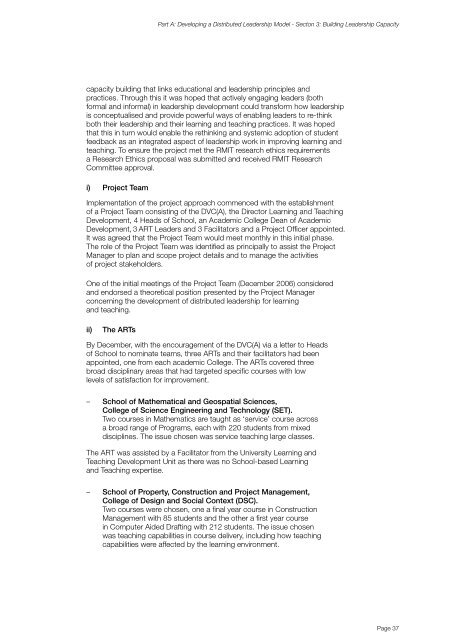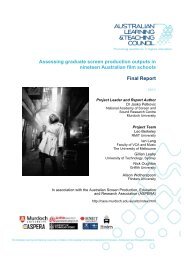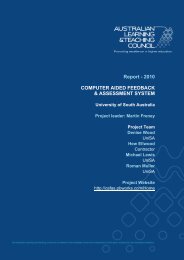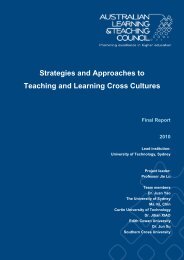student feedback and leadership - Office for Learning and Teaching
student feedback and leadership - Office for Learning and Teaching
student feedback and leadership - Office for Learning and Teaching
Create successful ePaper yourself
Turn your PDF publications into a flip-book with our unique Google optimized e-Paper software.
Part A: Developing a Distributed Leadership Model - Secton 3: Building Leadership Capacitycapacity building that links educational <strong>and</strong> <strong>leadership</strong> principles <strong>and</strong>practices. Through this it was hoped that actively engaging leaders (both<strong>for</strong>mal <strong>and</strong> in<strong>for</strong>mal) in <strong>leadership</strong> development could trans<strong>for</strong>m how <strong>leadership</strong>is conceptualised <strong>and</strong> provide powerful ways of enabling leaders to re-thinkboth their <strong>leadership</strong> <strong>and</strong> their learning <strong>and</strong> teaching practices. It was hopedthat this in turn would enable the rethinking <strong>and</strong> systemic adoption of <strong>student</strong><strong>feedback</strong> as an integrated aspect of <strong>leadership</strong> work in improving learning <strong>and</strong>teaching. To ensure the project met the RMIT research ethics requirementsa Research Ethics proposal was submitted <strong>and</strong> received RMIT ResearchCommittee approval.i) Project TeamImplementation of the project approach commenced with the establishmentof a Project Team consisting of the DVC(A), the Director <strong>Learning</strong> <strong>and</strong> <strong>Teaching</strong>Development, 4 Heads of School, an Academic College Dean of AcademicDevelopment, 3 ART Leaders <strong>and</strong> 3 Facilitators <strong>and</strong> a Project <strong>Office</strong>r appointed.It was agreed that the Project Team would meet monthly in this initial phase.The role of the Project Team was identified as principally to assist the ProjectManager to plan <strong>and</strong> scope project details <strong>and</strong> to manage the activitiesof project stakeholders.One of the initial meetings of the Project Team (December 2006) considered<strong>and</strong> endorsed a theoretical position presented by the Project Managerconcerning the development of distributed <strong>leadership</strong> <strong>for</strong> learning<strong>and</strong> teaching.ii)The ARTsBy December, with the encouragement of the DVC(A) via a letter to Headsof School to nominate teams, three ARTs <strong>and</strong> their facilitators had beenappointed, one from each academic College. The ARTs covered threebroad disciplinary areas that had targeted specific courses with lowlevels of satisfaction <strong>for</strong> improvement.––School of Mathematical <strong>and</strong> Geospatial Sciences,College of Science Engineering <strong>and</strong> Technology (SET).Two courses in Mathematics are taught as ‘service’ course acrossa broad range of Programs, each with 220 <strong>student</strong>s from mixeddisciplines. The issue chosen was service teaching large classes.The ART was assisted by a Facilitator from the University <strong>Learning</strong> <strong>and</strong><strong>Teaching</strong> Development Unit as there was no School-based <strong>Learning</strong><strong>and</strong> <strong>Teaching</strong> expertise.– – School of Property, Construction <strong>and</strong> Project Management,College of Design <strong>and</strong> Social Context (DSC).Two courses were chosen, one a final year course in ConstructionManagement with 85 <strong>student</strong>s <strong>and</strong> the other a first year coursein Computer Aided Drafting with 212 <strong>student</strong>s. The issue chosenwas teaching capabilities in course delivery, including how teachingcapabilities were affected by the learning environment.Page 37
















